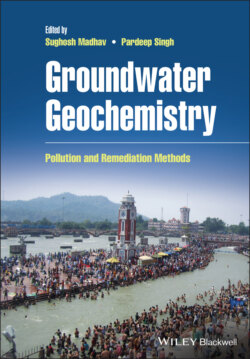Читать книгу Groundwater Geochemistry - Группа авторов - Страница 29
1.6.2 Manganese
ОглавлениеManganese is the 12th most abundant element in the environment, and it is a crucial component of plants and animals. It has a strong positive correlation with iron, and its chemistry is also somewhat like iron as both metals take part in redox reactions in weathering conditions. Manganese substitutes the iron, magnesium, or calcium in silicate structures as it is not a crucial component of any of the common silicate rock minerals. Manganese exists in divalent form in several igneous and metamorphic minerals as a small component, but it is an essential component of basalt. It has occurred in minerals like olivine, pyroxene, and amphibole and a minor amount generally occurred in dolomite and limestone as a substitute for calcium (CGWB 2014).
In soil, manganese arises from mineral weathering and atmospheric deposition instigating from both natural and anthropogenic sources. In soil solution, only the divalent ion form is stable, whereas Mn (III) and Mn (IV) are steady in the solid phase of soil. Soil parameters like acidity, wetness, organic matter content, biological activity, etc., affect the mobility of manganese. The solubility of manganese in the soil is controlled by redox potential and soil pH. Its mobility rises at lower pH or lower redox potential because these favour the reduction of insoluble manganese oxides. Manganese forms bonds with organic matter, oxides, and silicates, which lead to a decrease in solubility at soil pH above 6. Hence high pH and higher organic matter content usually lower the availability and solubility of manganese, whereas in acidic soils with low organic matter, it is readily available. The anaerobic conditions (at pH above 6) and aerobic conditions pH below 5.5 both resulted in an increase of solubility of manganese (CGWB 2014).
The existence of different minerals at the aquifer influence the levels of Mn found in groundwater from natural leaching processes. It usually occurs in deeper wells where the water normally interacts with the rock for an extended time. In groundwater, manganese often occurs together with iron as it originated from ferromagnesian, but its concentration is usually lower than iron. Though it is crucial for humans and other living beings, at higher concentration, it is lethal. The higher concentration of manganese is stated primarily from West Bengal, Tamil Nadu, Orissa, UP, and Bihar (Garduño et al. 2011).
